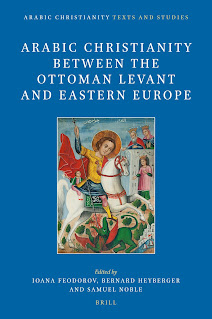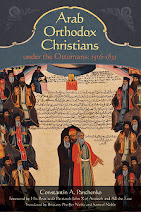Arabic original here. Please consider giving to the International Orthodox Christian Charities fund for Syria. Listen to a recent report about their work here.
Christian Refugees from Syria Number Around 30 Thousand. Dimensions of the Maaloula Catastrophe Go Beyond the Displacement of Hundreds of Families
The small number of Syrian Christian refugees cannot be compared to the number of Muslim refugees. Christians make up no more than ten percent of the Syrian population, at the highest estimate, and they have gone from the regions that they left to other regions of Syria. Those who have reached Lebanon are a small group, no more than thirty thousand people. A significant proportion of them have possessed Lebanese passports and Lebanese identity cards for a long time. This is, for example, the situation of a significant number of the inhabitants of the town of Maaloula, the latest of the Christian towns to be emptied, after waves of expulsions that have affected Christians in the Jazira (al-Qamishly and its region), Homs, Aleppo and Raqqa.
The overwhelming majority of Syrian Christians have been displaced within Syria. Those of them who have emigrated have done so on the basis of preparations made before and during the war through contacts with relatives in Europe and North America. Among those reaching Lebanon, there are some who are attempting to join those who went ahead to the Scandinavian countries and Canada, which they see as a paradise for refugees.
Syrian Christian refugees differ from their compatriots in that they do not come together in camps or in specific neighborhoods. The rich among them already had private homes in Lebanon and jobs inside and outside Syria. Some of them had obtained Lebanese nationality in the famous naturalization decree. The director of Caritas Lebanon, Fr Simon Faddoul, says that only a minority of them are seeking assistance.
Syrian Christian refugees are distributed in areas of the Northern Bekaa (al-Qa', Ras Baalbek and surrounding areas) and in Zahle, where there are a significant proportion of Syriacs staying with their Syriac cousins from Zahle. In Mount Lebanon, Syrian Christian refugees are found in Borj Hammoud and Sahel el-Metn, where Syrian Armenians are also residing with their Lebanese Armenian cousins. Syriacs live in in Sahel el-Metn and are centered in Bouchrieh and Ajaltoun. Some of them are distributed among the Syriac and Chaldean monasteries and this last group is in serious need of every type of support. They are being helped by church organizations, Caritas Lebanon, the Syriac League and other organizations that are active in dealing with the difficult humanitarian situation that requires the attention of state institutions. Fr Faddoul explains that Caritas offers assistance in a number of ways. There are several programs for food assistance and for contributing to paying rent, in addition to social and legal assistance. This is especially important, given that state security institutions insist on rigorously applying the law to Syrian Christian refugees but not to others, just as the law is applied rigorously in Christian areas without exceptions, unlike other areas.
In the past week, Fr Faddoul has signed an agreement with the Italian hospital Bambino Gesù (Christ Child) through the Pontifical Council Cor Unum in order to provide medical care for Lebanese and Syrian childen living in Lebanon. He envisions the plan beginning work in the city of Deir el-Ahmar and then expanding to several regions. There are mobil clinics operated in cooperation with Canadians in addition to the existing clinics, which are active every day to provide what is necessary.
The head of the Syriac League, Habib Afram, believes that the most important thing is for Syrian Christian families who have been displaced to not be swallowed up by emigration. He points to the high number of Iraqi Christians who have emigrated as proof of the immensity of the tragedy that Middle Eastern Christians are facing if things continue as they are.
However, the expulsion of around 400 Christian families from Maaloula is the worst blow to have affected the Greek Orthodox community in Syria, whose demographic presence had not been harmed much on account of the fact that the majority of its members are centered in regions far from the battle lines, such as the coastal region of Syria, Northwest Syria, Wadi al-Nasara and from there stretching down to areas bordering Northern Lebanon, which are mixed Alawite-Christian areas where the regime has maintained control. With the exception of Orthodox neighborhoods in Homs, they have not been displaced. However, dimensions of the Maaloula catastrophe go beyond the displacement and mass expulsion of Christians, to what Maaloula represents as an icon and symbol for Christians throughout the world. Afram repeats that Syrian Christians are "orphans, in the figurative sense of the word. The state does not help them because they do not reside in one place as a group. They receive no support from the Gulf or from Europe because of their religious affiliation."
As for Fr Faddoul, he believes that "the most important thing is to provide them with assistance and to keep it from being a matter of bidding and keeping personal accounts and selfish preference for this party or that. The tragedy is very great and the Lebanese know the meaning of displacement and wars."
Christian Refugees from Syria Number Around 30 Thousand. Dimensions of the Maaloula Catastrophe Go Beyond the Displacement of Hundreds of Families
The small number of Syrian Christian refugees cannot be compared to the number of Muslim refugees. Christians make up no more than ten percent of the Syrian population, at the highest estimate, and they have gone from the regions that they left to other regions of Syria. Those who have reached Lebanon are a small group, no more than thirty thousand people. A significant proportion of them have possessed Lebanese passports and Lebanese identity cards for a long time. This is, for example, the situation of a significant number of the inhabitants of the town of Maaloula, the latest of the Christian towns to be emptied, after waves of expulsions that have affected Christians in the Jazira (al-Qamishly and its region), Homs, Aleppo and Raqqa.
The overwhelming majority of Syrian Christians have been displaced within Syria. Those of them who have emigrated have done so on the basis of preparations made before and during the war through contacts with relatives in Europe and North America. Among those reaching Lebanon, there are some who are attempting to join those who went ahead to the Scandinavian countries and Canada, which they see as a paradise for refugees.
Syrian Christian refugees differ from their compatriots in that they do not come together in camps or in specific neighborhoods. The rich among them already had private homes in Lebanon and jobs inside and outside Syria. Some of them had obtained Lebanese nationality in the famous naturalization decree. The director of Caritas Lebanon, Fr Simon Faddoul, says that only a minority of them are seeking assistance.
Syrian Christian refugees are distributed in areas of the Northern Bekaa (al-Qa', Ras Baalbek and surrounding areas) and in Zahle, where there are a significant proportion of Syriacs staying with their Syriac cousins from Zahle. In Mount Lebanon, Syrian Christian refugees are found in Borj Hammoud and Sahel el-Metn, where Syrian Armenians are also residing with their Lebanese Armenian cousins. Syriacs live in in Sahel el-Metn and are centered in Bouchrieh and Ajaltoun. Some of them are distributed among the Syriac and Chaldean monasteries and this last group is in serious need of every type of support. They are being helped by church organizations, Caritas Lebanon, the Syriac League and other organizations that are active in dealing with the difficult humanitarian situation that requires the attention of state institutions. Fr Faddoul explains that Caritas offers assistance in a number of ways. There are several programs for food assistance and for contributing to paying rent, in addition to social and legal assistance. This is especially important, given that state security institutions insist on rigorously applying the law to Syrian Christian refugees but not to others, just as the law is applied rigorously in Christian areas without exceptions, unlike other areas.
In the past week, Fr Faddoul has signed an agreement with the Italian hospital Bambino Gesù (Christ Child) through the Pontifical Council Cor Unum in order to provide medical care for Lebanese and Syrian childen living in Lebanon. He envisions the plan beginning work in the city of Deir el-Ahmar and then expanding to several regions. There are mobil clinics operated in cooperation with Canadians in addition to the existing clinics, which are active every day to provide what is necessary.
The head of the Syriac League, Habib Afram, believes that the most important thing is for Syrian Christian families who have been displaced to not be swallowed up by emigration. He points to the high number of Iraqi Christians who have emigrated as proof of the immensity of the tragedy that Middle Eastern Christians are facing if things continue as they are.
However, the expulsion of around 400 Christian families from Maaloula is the worst blow to have affected the Greek Orthodox community in Syria, whose demographic presence had not been harmed much on account of the fact that the majority of its members are centered in regions far from the battle lines, such as the coastal region of Syria, Northwest Syria, Wadi al-Nasara and from there stretching down to areas bordering Northern Lebanon, which are mixed Alawite-Christian areas where the regime has maintained control. With the exception of Orthodox neighborhoods in Homs, they have not been displaced. However, dimensions of the Maaloula catastrophe go beyond the displacement and mass expulsion of Christians, to what Maaloula represents as an icon and symbol for Christians throughout the world. Afram repeats that Syrian Christians are "orphans, in the figurative sense of the word. The state does not help them because they do not reside in one place as a group. They receive no support from the Gulf or from Europe because of their religious affiliation."
As for Fr Faddoul, he believes that "the most important thing is to provide them with assistance and to keep it from being a matter of bidding and keeping personal accounts and selfish preference for this party or that. The tragedy is very great and the Lebanese know the meaning of displacement and wars."








No comments:
Post a Comment